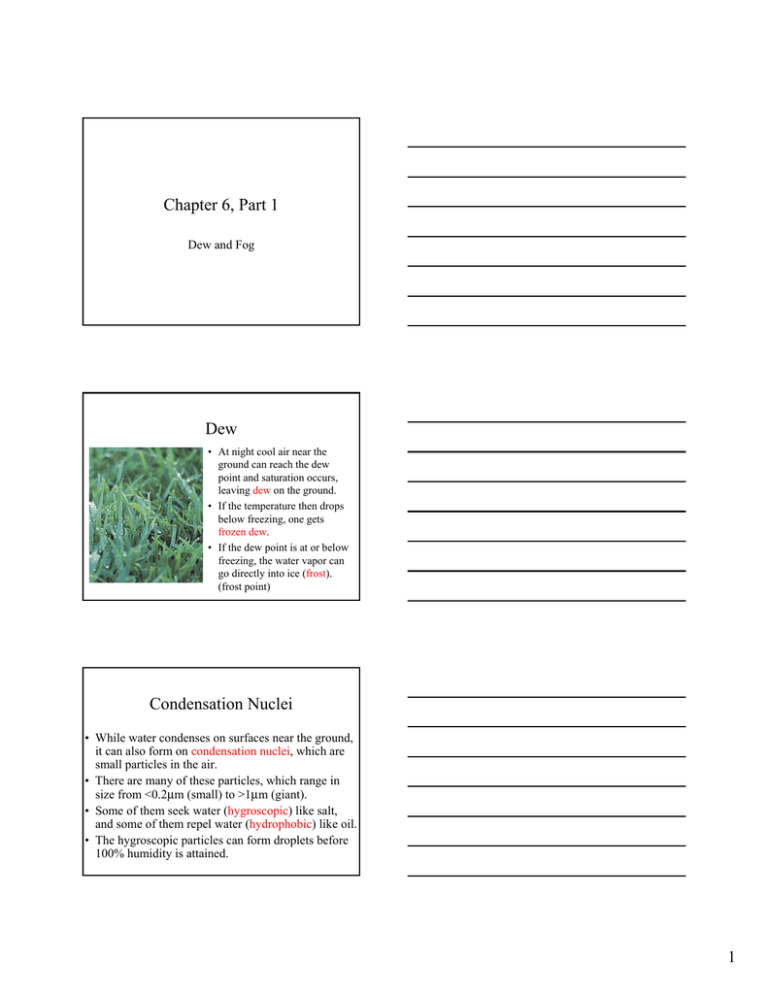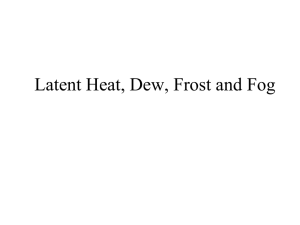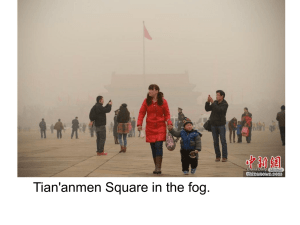Chapter 6, Part 1 Dew Dew and Fog
advertisement

Chapter 6, Part 1 Dew and Fog Dew • At night cool air near the ground can reach the dew point and saturation occurs, leaving dew on the ground. • If the temperature then drops below freezing, one gets frozen dew. • If the dew point is at or below freezing, the water vapor can go directly into ice (frost). (frost point) Condensation Nuclei • While water condenses on surfaces near the ground, it can also form on condensation nuclei, which are small particles in the air. • There are many of these particles, which range in size from <0.2µm (small) to >1µm (giant). • Some of them seek water (hygroscopic) like salt, and some of them repel water (hydrophobic) like oil. • The hygroscopic particles can form droplets before 100% humidity is attained. 1 Haze • Haze is created by a thin layer of dust, salt, or other particles. • During the day when the relative humidity is low, the haze is dry. • At night, if the relative becomes 100% or close to it (even 60-80%), water vapor begins to condense, creating a dull gray or white layer of wet haze. Haze Picture Layer of haze on a lake on a cool winter morning. Fog • As water continues to condense in tiny floating droplets, eventually the visibility lowers to less than 1km, giving fog. • The tiny fog droplets do fall to the earth, but new ones are constantly being added. • Fog is formed by – Increasing the relative humidity (cooling) – Adding water to the air (evaporation, mixing). 2 Radiation Fog • • • • Shallow layer of moist air near ground. Heat radiated away at night. Moist air becomes saturated creating fog. Sometimes called ground fog or valley fog, since cold heavy air drains downhill. • After sun rise, the ground heats up and the fog will “burn off.” Radiation Fog Picture • Radiation fog in a valley. Advection Fog • Forms when moist air moves over a cold surface. • Common on the Pacific coast where surface water near the coast is colder than farther offshore. • The moisture provided by the fog (fog drip) is important for plants like the redwoods. • If the ground has been cooled by radiation, it is called advection-radiation fog. 3 Advection Fog Picture Upslope Fog • Formed when moist air moves up along an elevated plain, hill, or mountain. • As the air cools, fog forms. Evaporation (Mixing) Fog • Formed when cold air mixes with warmer moist air. Sometimes called steam fog. • Examples: – – – – Exhaling in cold weather Cold air moving over water water (pool or lake) Fog over a wet surface after a rain shower Warm rain falling through cold moist air 4 Average Number of Foggy Days New England Pacific Coast Appalachian highlands Summary • Dew forms when water condenses on the ground as temperature falls below the dew point. • Haze and fog are due to water condensing on condensation nuclei. • Fog can be created either by – cooling the air (radiation fog) or – adding moisture to the air (advection, upslope, evaporation, and mixing fog). 5









